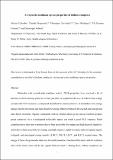Files in this item
A trip in the nonlinear optical properties of iridium complexes
Item metadata
| dc.contributor.author | Colombo, Alessia | |
| dc.contributor.author | Dragonetti, Claudia | |
| dc.contributor.author | Guerchais, Véronique | |
| dc.contributor.author | Hierlinger, Claus | |
| dc.contributor.author | Zysman-Colman, Eli | |
| dc.contributor.author | Roberto, Dominique | |
| dc.date.accessioned | 2021-03-30T23:41:23Z | |
| dc.date.available | 2021-03-30T23:41:23Z | |
| dc.date.issued | 2020-07-01 | |
| dc.identifier | 266845269 | |
| dc.identifier | ab3fadb7-93d8-4671-9889-eea5e444b414 | |
| dc.identifier | 85082555902 | |
| dc.identifier | 000525870200011 | |
| dc.identifier.citation | Colombo , A , Dragonetti , C , Guerchais , V , Hierlinger , C , Zysman-Colman , E & Roberto , D 2020 , ' A trip in the nonlinear optical properties of iridium complexes ' , Coordination Chemistry Reviews , vol. 414 , 213293 . | en |
| dc.identifier.issn | 0010-8545 | |
| dc.identifier.uri | https://hdl.handle.net/10023/21744 | |
| dc.description | We thank MIUR and the National Interuniversity Consortium of Materials Science and Technology (Project INSTMMI012) for support. | en |
| dc.description.abstract | Molecules with second-order nonlinear optical (NLO) properties have received a lot of attention in the last twenty years due to their potential use in photonic devices. In order to have a large second-order NLO response, a compound should not be centrosymmetric, it should have low energy charge-transfer transitions and there should be a large difference between the excited state and ground state dipole moments. Organic compounds with an electron-donor group and an electron-acceptor group connected via a π-conjugated polarizable spacer can reach a good NLO response. Metal complexes have also shown promise due to their accessible low-energy and high intensity ligand-to- metal due to their accessible low-energy and high-intensity ligand-to-metal, metal-to-ligand, ligand- to-ligand, and intraligand charge transfer (LMCT, MLCT, LLCT, and ILCT) excited states. The energy of these charge transfer states can be readily tuned as a function of the nature and the oxidation state of the metal centre and by the ligands that surround it. Among them, iridium complexes are particularly fascinating, not only for their attractive second-order NLO properties but also for their remarkable two-photon absorption (TPA) properties, a third-order NLO process which is of interest for a number of photonic and optoelectronic applications. The goal of this review is to show the potential of iridium compounds as molecular materials with NLO-activity. First, the principles of second-order nonlinear optics will be briefly introduced, then the review will illustrate the main families of second-order NLO iridium complexes, producing examples of iridium(I) complexes with monodentate nitrogen donor ligands (substituted pyridines and stilbazoles, azaphenanthrene and azachrysene), iridium(III) complexes with terpyridines, bis- cyclometalated phenylpyridine iridium(III) compounds with b-diketonate ligands, tris- cyclometalated phenylpyridine iridium(III) compounds, bis-cyclometalated phenylpyridine iridium(III) complexes with diimines or aryl isocyanides. Through this survey of NLO-phores we show how it is possible to tune the second-order NLO response by a suitable choice of the substituents about the ligands. The emphasis is on second-order NLO properties determined in solution at the molecular level, but examples of nanoorganization of some NLO-active iridium complexes in polymeric matrices to give second-order NLO-active thin films are presented as well. Further, some iridium complexes have shown potential as versatile NLO redox-switching materials and these are described in this review. Finally, a few examples of iridium complexes with TPA properties are given in the last section of the review. The coverage is not comprehensive but provides a suitable introduction to NLO-active iridium complexes and a framework for understanding their potential. | |
| dc.format.extent | 1451683 | |
| dc.language.iso | eng | |
| dc.relation.ispartof | Coordination Chemistry Reviews | en |
| dc.subject | Iridium complexes | en |
| dc.subject | Nonlinear optics | en |
| dc.subject | Second harmonic generation | en |
| dc.subject | Two-photon absorption | en |
| dc.subject | QD Chemistry | en |
| dc.subject | T-NDAS | en |
| dc.subject.lcc | QD | en |
| dc.title | A trip in the nonlinear optical properties of iridium complexes | en |
| dc.type | Journal item | en |
| dc.contributor.institution | University of St Andrews. EaSTCHEM | en |
| dc.contributor.institution | University of St Andrews. School of Chemistry | en |
| dc.contributor.institution | University of St Andrews. Organic Semiconductor Centre | en |
| dc.description.status | Peer reviewed | en |
| dc.date.embargoedUntil | 2021-03-31 |
This item appears in the following Collection(s)
Items in the St Andrews Research Repository are protected by copyright, with all rights reserved, unless otherwise indicated.

